Introduction to Cloud Security in 2023
As we step into 2023, cloud security remains a top priority for businesses worldwide. With the increasing adoption of cloud services, ensuring the safety and integrity of data in the cloud has never been more critical. This article explores the best practices for cloud security in 2023, offering actionable strategies to protect your digital assets.
Understand Your Shared Responsibility Model
One of the first steps in securing your cloud environment is understanding the shared responsibility model. Cloud service providers (CSPs) and customers share the responsibility for security. While CSPs secure the infrastructure, customers must protect their data, applications, and access management.
Implement Strong Access Control Measures
Access control is a cornerstone of cloud security. Implementing strong authentication mechanisms, such as multi-factor authentication (MFA), and adhering to the principle of least privilege (PoLP) can significantly reduce the risk of unauthorized access.
Use Multi-Factor Authentication (MFA)
MFA adds an extra layer of security by requiring users to provide two or more verification factors to gain access to cloud resources. This simple step can prevent most account compromise attacks.
Adopt the Principle of Least Privilege (PoLP)
PoLP ensures that users have only the access necessary to perform their job functions. Regularly reviewing and adjusting permissions can minimize potential damage from insider threats or compromised accounts.
Encrypt Data at Rest and in Transit
Encryption is a powerful tool for protecting sensitive information. Encrypting data at rest and in transit ensures that even if data is intercepted or accessed without authorization, it remains unreadable and secure.
Regularly Update and Patch Systems
Keeping your cloud environments and applications up to date is crucial for security. Regular updates and patches address vulnerabilities that could be exploited by attackers. Automating this process can help ensure timely updates.
Monitor and Respond to Threats in Real-Time
Continuous monitoring of your cloud environment allows for the early detection of suspicious activities. Implementing security information and event management (SIEM) solutions can help in identifying and responding to threats in real-time.
Backup Your Data Regularly
Data loss can occur due to various reasons, including cyberattacks, human error, or natural disasters. Regular backups ensure that you can recover your data quickly and minimize downtime in case of an incident.
Educate Your Team on Security Best Practices
Human error is a significant vulnerability in cloud security. Educating your team on security best practices, such as recognizing phishing attempts and securing their devices, can greatly enhance your overall security posture.
Conclusion
Cloud security is an ongoing process that requires attention and adaptation to new threats. By implementing these best practices in 2023, businesses can strengthen their cloud security and protect their valuable data from emerging threats. Remember, security is not a one-time effort but a continuous commitment to safeguarding your digital assets.
